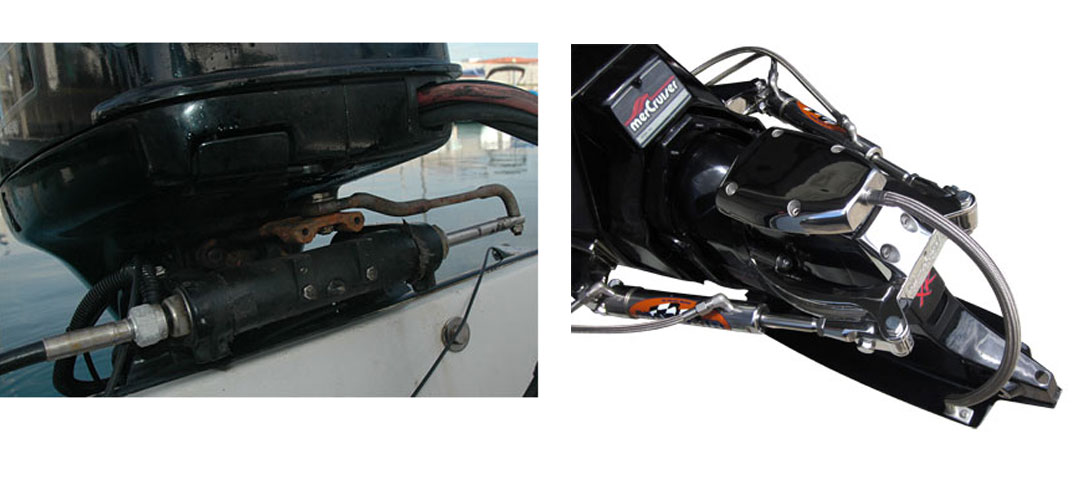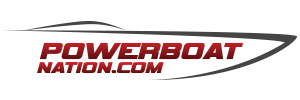A proper steering system is a critical factor in achieving good boat handling performance and safe operation. Engine horsepower, proper torque, hull design and boat speed, in their varied combinations exert loads on steering systems. The resulting steering forces vary considerably from boat to boat and motor to motor, therefore you must take extreme care to ensure that the steering system you select matches your application. The following guidelines will assist you in making a steering system selection, and in particular, alert you to potential problem areas.
Mechanical Steering Cable on an Outboard
Hydraulic Steering System on Bravo Drive.
Hydraulic Steering is recommended for larger boats.
With an increase in speed and horsepower, steering forces increase considerably. High performance boats often leave and re-enter the water, momentarily creating high shock loads on the steering system. Additionally, certain hull designs may have a tendency to lose stability at high speeds, a condition commonly called “chine walk”.
The speed at which instability begins to occur varies significantly among different type boats. A twin cable or hydraulic steering system is generally recommended for boats moving at higher speeds.
The torque of large outboard motors may cause a boat to veer sharply from a straight heading or make it difficult to bring out of a turn. Mechanical steering systems must have appropriate mechanical advantage for ease of operation, and the steering cable has to be installed free of kinks, sharp bends or obstructions, to permit the boat operator to maneuver the boat readily at any speed.
Corrosion of steering cables can lead to stiff operation, complete seizure, and/or loss of steering control. The steering cable should be regularly inspected for cracks or cuts. If found, the cable should be replaced. If there are no signs of cracking, the cable output end and the engine tilt tube should be cleaned thoroughly, coated with a quality marine lubricant, then properly reassembled and maintained according to the engine manufacturers specifications. Corrosive buildup can be minimized through this simple routine maintenance. Whenever possible, the boat builder and/or dealer should select Hardin Marine cables which all have stainless steel output ends to reduce corrosion, especially on boats used in salt water. Even then, if a boat is not going to be used for extended periods of time, it is recommended to completely remove the cable output end from the thru-tube and properly prepare for storage.
The routing of steering cables is also a very important consideration. Multiple bends in the cable and small bend radius will contribute to cable backlash and steering inefficiency. Cables should be routed with as few bends as possible and with the optimum radii achievable.
- Excessive cable length results in excessive backlash and cable inefficiency. If an installation requires a 14 foot cable, a 14 foot cable should be used. Do not add unnecessary length.
- Larger boats with displacement hulls and inboard rudders can create steering loads that exceed the capability of mechanical steering systems commonly used on runabouts. Hydraulic steering systems are better suited to function under high steering loads.
- Generally mechanical steering systems can be used on boats up to 35 feet in length, with a maximum working tiller arm load of 300 pounds rotary.
- Some high performance boat engine combinations develop steering instability at high speed. Instability becomes more prevalent in boats faster than 50 MPH. A twin cable system or a hydraulic steering system is recommended for these types of boats.
- Hydraulic steering is recommended for all boats, not equipped with power steering, that have a working load of 700 pounds rack or more at the tiller end.
- Maximum steering wheel diameter is 16″.
- Mechanical steering systems should not be used on boats equipped with engines that exceed the maximum horsepower rating of the boat.
For the best possible results, plan your cable routing by the most direct route possible. Bend radius should be 8″ or more. Keep the number of bends to a minimum. In any case, do not bend the cable less than the minimum specified bend radius. Trim settings of outboards and stern drives can markedly affect steering loads and maneuverability of your boat. Motor trim tabs should be set according to the motor manufacturers recommendations. After installation, test your boat for ease of steering though the full range of motor trim angles. Varying trim angles can change steering loads on any given system. Mounting position of an outboard can also affect steering loads and boat handling characteristics. Strictly adhere to the mounting specifications established by the boat builder and engine manufacturer.





